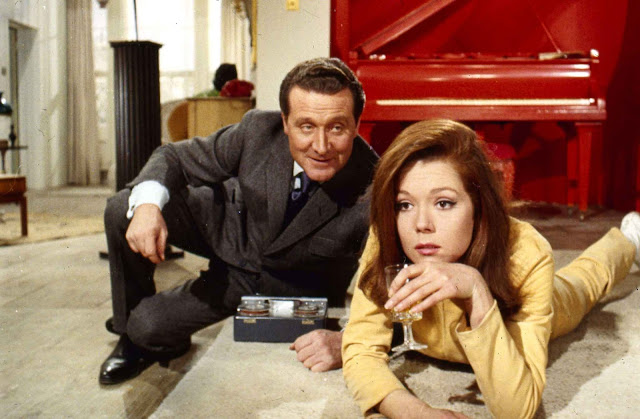The British television series "The Avengers" ran from 1961 to 1969 and is still considered one of the most ground-breaking series ever produced. The show was seen in more than 90 countries and it forever changed fashion and design--exporting, to the world, an eclectic British mod/pop aesthetic. If you've never seen it, you need to take a look. If it's been a while, take another look--you will be inspired.
The plots were amusing and full of that British dry wit, but it was the fashion and set-designs that captivated the world. A mixture of traditional British reserve (the heroes and villains were always suave and polite and wealthy) and the excitement of the new. Every time I see a Miles Redd room or a Kelly Wearstler designed house, I think of this series.
The costume design always pushed the envelope and included the work of John Bates and a very young Pierre Cardin. John Steed (Patrick Macnee) was dapper and more British than the British. Mrs. Peel (Diana Rigg) was quite mod and soon became a fashion icon; featured in endless magazine spreads. The fashions still look very chic.
 |
| Patrick Macnee with Twiggy. |
The set designers included Harry Pottle (later tapped for the James Bond movies), Wilfred Shingleton, and Robert Jones. The look was very eclectic, mixing antiques with mod, pop, and a whole lot of surrealism.
Of course, the great charm of the series was the juxtaposition of the old/traditional with the new/mod. John Steed's clothing and manner was actually a throwback to a more genteel and rather stylized British gentleman (although foreign viewers assumed he represented the current British gentleman). His female partner was always younger, a bit brash, and stylishly modern. The revelation was that both could coexist happily together. The juxtaposition extended to the sets and it was quite exciting to realize that "old fusty" antiques complimented new modern and pop-art pieces. Both the fashions and the décor were soon available (often as knock-offs) in the more fashionable department stores.

























Comments
Post a Comment